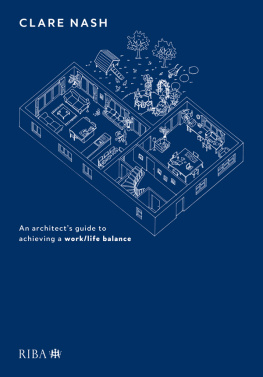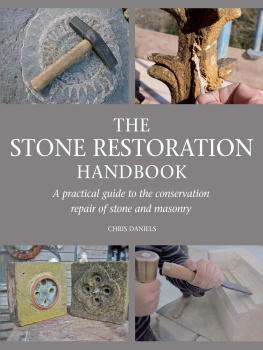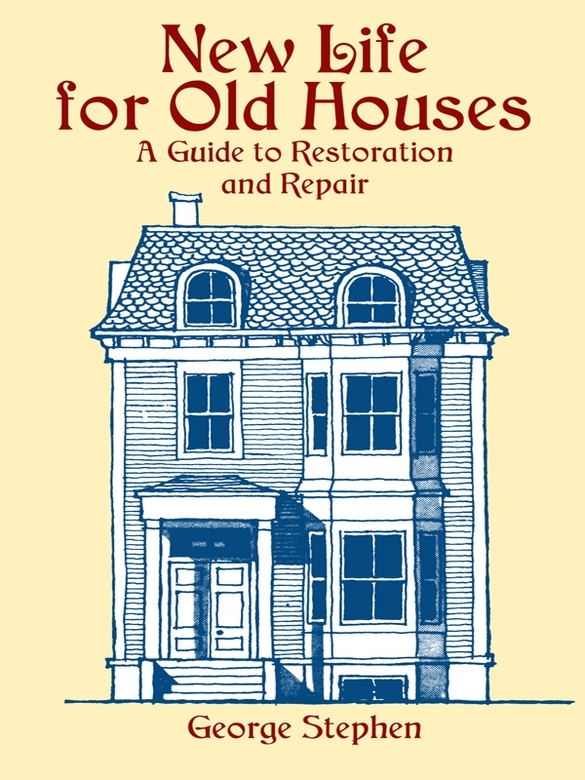Acknowledgments
Many of the ideas in this book grew out of material originally prepared for a series of talks during three courses for rehabilitation specialists at the Massachusetts Bay Community College from 1968 and 1970, sponsored by the U.S. Department of Housing and Urban Development. I would like to thank the students of these courses, who, by the genuine interest they showed in rehabilitation design, persuaded me that it was a teachable subject, and to acknowledge a special debt of gratitude to the director, Prof. George C. Rogers, Jr., who was the first to suggest the possibility of this book and to prod me into doing something about it.
I would also like to thank another prodderarchitect Tom Vitanza of the National Park Servicewho started everything up again by persuading me that the book was still needed and worth reprinting.
Appendix A:
The Secretary of the Interiors Standards for Rehabilitation
The secretary of the interior is responsible for establishing standards for all programs under department authority and for advising federal agencies on the preservation of historic properties listed or eligible for listing in the National Register of Historic Places. In partial fulfillment of this responsibility, the Secretary of the Interiors Standards for Historic Preservation Projects have been developed to direct work undertaken on historic buildings. In addition to guiding federally funded projects, these standards have been used to determine if a rehabilitation project qualifies as a certified rehabilitation eligible for federal tax credits. They have also been used by state and local officials to review both federal and nonfederal rehabilitation proposals and have been adopted by a number of historic district and planning commissions across the country.
From The Secretary of the Interiors Standards for Rehabilitation and Guidelines for Rehabilitating Historic Buildings, published by Technical Preservation Services, U.S. Department of the Interior, 1983. Note: The complete guidelines are reprinted in the Preservation Press book Respectful Rehabilitation (see Suggested Reading).
The Standards for Rehabilitation are one section of the over-all preservation standards and address the most prevalent treatment today: rehabilitation. Rehabilitation is defined as the process of returning a property to a state of utility, through repair or alteration, to make possible an efficient contemporary use while preserving those portions and features of the property that are significant to its historical, architectural, and cultural values.
The Standards for Rehabilitation are as follows:
- Every reasonable effort shall be made to provide a compatible use for a property which requires minimal alteration of the building, structure, or site and its environment or to use a property for its originally intended purpose.
- The distinguishing original qualities or character of a building, structure, or site and its environment shall not be destroyed. The removal or alteration of any historic material or distinctive architectural features should be avoided when possible.
- All buildings, structures, and sites shall be recognized as products of their own time. Alterations which have no historical basis and which seek to create an earlier appearance shall be discouraged.
- Changes which may have taken place in the course of time are evidence of the history and development of a building, structure, or site and its environment. These changes may have acquired significance in their own right, and this significance shall be recognized and respected.
- Distinctive stylistic features or examples of skilled craftsmanship which characterize a building, structure, or site shall be treated with sensitivity
- Deteriorated architectural features shall be repaired rather than replaced, wherever possible. In the event replacement is necessary, the new material should match the material being replaced in composition, design, color, texture, and other visual qualities. Repair or replacement of missing architectural features should be based on accurate duplications of features, substantiated by historical, physical, or pictorial evidence rather than on conjectural designs or the availability of different architectural elements from other buildings or structures.
- The surface cleaning of structures shall be undertaken with the gentlest means possible. Sandblasting and other cleaning methods that will damage the historic building materials shall not be undertaken.
- Every reasonable effort shall be made to protect and preserve archeological resources affected by or adjacent to any project.
- Contemporary design for alterations and additions to existing properties shall not be discouraged when such alterations and additions do not destroy significant historic, architectural, or cultural material and such design is compatible with the size, scale, color, material, and character of the property, neighborhood, or environment.
- Wherever possible, new additions or alterations to structures shall be done in such a manner that if such additions or alterations were to be removed in the future, the essential form and integrity of the structure would be unimpaired.
Appendix B:
Energy Retrofitting: The Secretary of the Interiors Rehabilitation Guidelines
Some character-defining features of a historic building or site such as cupolas, shutters, transoms, skylights, sun rooms, porches, and plantings also play a secondary energy conserving role. Therefore, prior to retrofitting historic buildings to make them more energy efficient, the first step should always be to identify and evaluate the existing historic features to assess their inherent energy conserving potential. If it is determined that retrofitting measures are necessary, then such work needs to be carried out with particular care to assure that the buildings historic character is preserved in the process of rehabilitation.
RECOMMENDED
District/Neighborhood
Maintaining those existing landscape features which moderate the effects of the climate on the setting, such as deciduous trees, evergreen windblocks, and lakes or ponds.
From The Secretary of the Interiors Standards for Rehabilitation and Guidelines for Rehabilitating Historic Buildings, published by Technical Preservation Services, U.S. Department of the Interior, 1983.
Building Site
Retaining plant materials, trees, and landscape features, especially those which perform passive solar energy functions such as sun shading and wind breaks.
Installing freestanding solar collectors in a manner that preserves the historic propertys character-defining features. Designing attached solar collectors, including solar greenhouses, so that the character-defining features of the property are preserved.
Masonry, Wood, Architectural Metals
Installing thermal insulation in attics and in unheated cellars and crawl spaces to increase the efficiency of the existing mechanical systems.
Installing insulating material on the inside of masonry walls to increase energy efficiency where there is no character-defining interior molding around the window or other interior architectural detailing.
Installing passive solar devices such as a glazed trombe wall on a rear or inconspicuous side of the historic building.
Roofs
Placing solar collectors on non-character-defining roofs or roofs of nonhistoric adjacent buildings.












